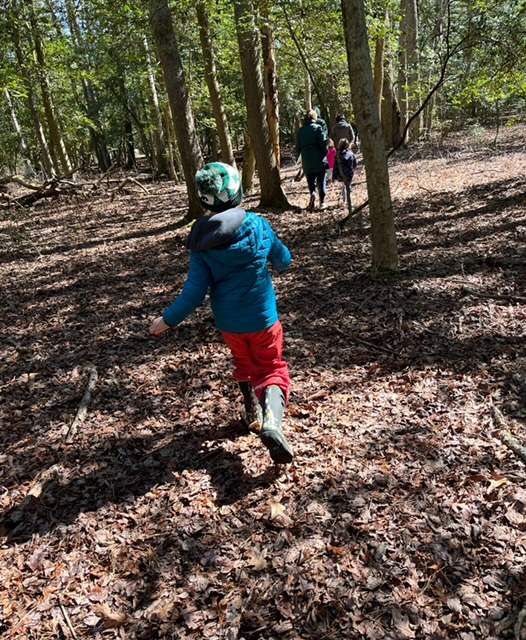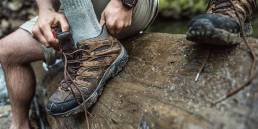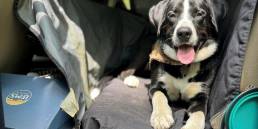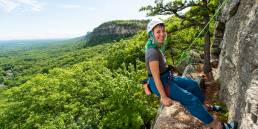If you had told me a year ago that the best part of my week would be the weekly nature class with my son, I would have laughed. I have not always been “outdoorsy.” In fact, for much of my life, that would have been one of the last adjectives people would use to describe me. When I started homeschooling my son, though, I knew I wanted him to be outside, be exposed to nature, and learn about the natural world.
I had been slowly realizing that I enjoyed being outside more (even though my “outdoor” time was mostly just sitting outside at Starbucks and reading or doing work) and that when I was outside more, my stress level was reduced. I still felt a little bit like an imposter, but kept pushing myself to get outside more, even if it was “just” sitting outside and reading, or taking a walk. I had also read occupational therapist Angela Hanscom’s book Balanced and Barefoot: How Unrestricted Outdoor Play Makes for Strong, Confident, and Capable Children, and knew the benefits of being outside, especially for disabled children.
My son has childhood apraxia of speech, as well as dyspraxia, also known as developmental coordination disorder. Both are lifelong conditions with no cure, but both are able to be managed and treated with therapies like speech therapy, physical therapy, and occupational therapy. What this means for my son is that, with dyspraxia, his muscle tone is lower than that of other kids his age, he’s not as coordinated, he tires more easily, his balance is not as good, and he can’t always figure out how to jump or climb over things or have the strength to do so. Despite this, he’s an enthusiastic kid who loves playing at the park.
Last September, I saw a post on Facebook from a local day camp that a friend mentioned, about a weekly nature class for kids. It was originally geared toward younger kids before they started school (i.e., ages 3-6), but older homeschool kids could go, too. I emailed the director and let her know about my son’s disabilities and asked if we could still join, and her answer was an enthusiastic yes. (This has not always been the case with various childhood programs, including some nature programs—ableism is alive and well throughout childhood and its trappings).

Getting Out There
As with most new things, the first class got off to a bit of a rocky start when I walked between the metal poles of a swing set and right into a spiderweb. “SHIT SHIT SHIT I HATE NATURE,” I screamed, momentarily forgetting there were tiny humans around. Thankfully, class hadn’t started yet and not too many people were there, as I frantically combed my fingers through my hair, hoping little Charlotte hadn’t hitched a ride.
Things could only get better from there, right?
The format of the classes looks like this: We gather outside in a circle and go over the topic of the day—things like fungi, birds, farm animals, animal hibernation, bugs, and much more—and read a picture book about the topic, maybe look at samples or materials, and then we all go on a short hike on one of the various trails on the property. We learn proper hiking behavior and habits (e.g., stay on trail, don’t eat anything you don’t know, be aware of your surroundings), learn about the flora, fauna, and wildlife around us, and discuss seasonal and environmental changes in the woods.
When I say hike, I mean 20-minute walks (30 minutes at the absolute most for longer adventures). I’m also not talking about steep hills or switchbacks: these are easy hikes with some inclines, but mostly they’re hikes that enable us to really slow down, breathe in the air and the smells of the forest, and observe everything around us. We don’t need fancy hiking apparel or specialized gear (my son hikes in his Oaki boots that help keep out the lake water when the kids inevitably decide to wade in).
In the beginning, my son’s balance was shaky—literally. If there was a plank, he’d need to hold my hand to walk across. He didn’t always know how to climb over a fallen tree, and it would take him some time to coordinate movements. But as we attended fall, then winter, then spring sessions, I watched him become more grounded in his body. And now, more than a year later, we are at the tail end of this year’s fall session and already looking forward to the winter session. My son’s gait and core strength have improved and his confidence is higher. His endurance and energy on hikes are noticeably better, and he’s taking more appropriate physical risks. He has also become an enthusiastic naturalist who will discuss birds, leaves, bugs, animals—you name it. We no longer go to OT, but before our OT left, even she mentioned how much he had improved, and she was sure that our nature class hikes and being outside more had a hand in that.

It’s Not Just for My Son
But my son isn’t the only one who’s benefitted from the class.
I’m a single mom, I work full-time, and I homeschool. My stress level is generally high, and I can be short on patience. Having this dedicated outdoor time with my son, the two of us together, has helped our relationship. Getting outside in the natural world, where we both may feel a little out of place, gave us permission to be imperfect and free. No one expected anything from us except participation, and the inclusive environment the facilitator had cultivated meant that both of us could let our guard down and just be ourselves. We talk about what we’ve learned that day, go on short hikes at other times, and look forward to class each week.
Earlier this year, in March, I woke up one morning with half my face drooping. I waited until the next day to go to urgent care, who promptly sent me to the ER to rule out a stroke, even though by then I assumed it was Bell’s palsy. Because it wasn’t as severe as it typically presents, the ER said it might be affecting a peripheral nerve, and that it was most likely brought on by stress and lack of sleep in my case. I realized that I had to make some pretty major changes in my life and take steps to reduce stress as much as possible while increasing the joy in my life.
I asked myself when I was happiest, and I realized that the time outside at class was the calmest part of my week. It was a time when my shoulders relaxed, I breathed more deeply, and I was more in my body than at any other time. The fresh air, the sunshine, the changing weather, the physical exertion, and learning new things about nature were all working together to bring my stress levels down and make me happier. The hikes were basic but were good introductions to learning about fungi, poisonous plants, and forest animals we might encounter, and just getting outside on the trail in any weather was immensely helpful in habit forming.
Ever since then, I’ve been trying to get outside more, hike more, and even signed up for a hiking trip to hike part of the Appalachian Trail in late spring next year. Turns out that I’m more “outdoorsy” than I thought!

Hiking with my son—even these “little” hikes in our nature class—has opened up a whole new world for both of us. For my son, it has been like our own personal OT and helped his physical coordination, and it’s bolstered his confidence and love for science and nature as well. It’s helped reduce my stress level and shown me that maybe I can be outdoorsy, even when people think I can’t. And for our relationship, it’s been a shared experience that makes us laugh, gets us moving, and has given us memories that we’ll have forever.
Jaime Herndon
Jaime Herndon is a science writer and editor who loves the national parks and enjoys introducing her son to hiking and being outdoors. She’s so thankful that homeschooling has been the catalyst for getting her outside more and one day hopes to hike the Appalachian Trail.
Related Posts
April 24, 2024
What to Bring When Road Tripping with Your Dog
Prepare for the ultimate road trip with…




